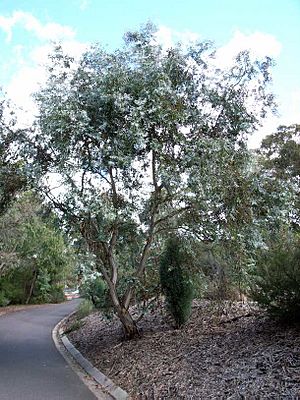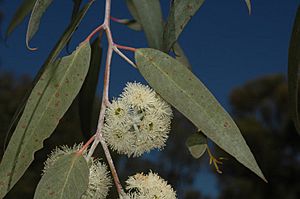Risdon peppermint facts for kids
Quick facts for kids Risdon peppermint |
|
|---|---|
 |
|
| Eucalyptus risdonii in the ANBG | |
| Scientific classification | |
| Genus: |
Eucalyptus
|
| Species: |
risdonii
|
| Synonyms | |
|
|
The Eucalyptus risdonii, often called the Risdon peppermint, is a special kind of small tree. It grows only in a tiny part of southern Tasmania, Australia. This tree has smooth bark that can be many colors. Its leaves are usually egg-shaped and grow in pairs. The Risdon peppermint produces white flowers and unique cup-shaped fruits.
Contents
What Does It Look Like?
The Risdon peppermint tree usually grows up to 8 m (26 ft) (about 26 feet) tall. It has smooth bark that can be grey, yellow, white, or cream-colored. This tree also has a special woody swelling at its base called a lignotuber. This helps the tree regrow after fires.
Most of the leaves on a Risdon peppermint tree are young leaves. These young leaves are egg-shaped and have a dull, blue-green color (this is called glaucous). They grow in pairs directly on the stem, without a stalk (this is called sessile). Each leaf can be 20–50 mm (0.79–1.97 in) (about 1-2 inches) long and wide.
If the tree grows older, it might develop some adult leaves. These are dull green and shaped like a spear. They can be up to 100 mm (3.9 in) (about 4 inches) long and 20 mm (0.79 in) (less than an inch) wide.
Flowers and Fruit
The flower buds grow in groups of nine to fifteen. They are found where the leaves meet the stem. Each group of buds sits on a stalk called a peduncle, which is 5–25 mm (0.20–0.98 in) long. The individual buds have smaller stalks called pedicels, about 2–5 mm (0.079–0.197 in) long.
Mature buds are oval or club-shaped. They are 4–7 mm (0.16–0.28 in) long and 3–5 mm (0.12–0.20 in) wide. Each bud has a cap, called an operculum, which is rounded or flat. The Risdon peppermint flowers from November to January, and its flowers are white.
After the flowers, the tree produces woody fruits. These fruits are like small cups, cones, or half-spheres. They are 6–10 mm (0.24–0.39 in) long and 6–9 mm (0.24–0.35 in) wide. The parts that open to release seeds are usually below the rim of the fruit.
How It Got Its Name
The Eucalyptus risdonii was first officially described in 1847. This was done by a scientist named Joseph Dalton Hooker. He wrote about it in a science journal called the London Journal of Botany.
The second part of its scientific name, risdonii, comes from the place where the first example of this tree was found. This place is called Risdon in Tasmania.
Where Does It Live?
The Risdon peppermint is only found in a very specific area. It grows on the dry, sunny slopes on the eastern side of the River Derwent. You can find it near the towns of Risdon and Grass Tree Hill in Tasmania. It prefers to grow in open forests on ridges that face the north-west.
This tree is also interesting because it is thought to be a "juvenilised" form of a closely related species, E. tenuiramis. This means it keeps its young features for a longer time.
Is It Safe? (Conservation Status)
The Risdon peppermint is considered a "rare" species. This means there are not many of these trees left in the wild. The Tasmanian Government protects it under their Threatened Species Protection Act 1995. This law helps to keep rare plants and animals safe.


